

150,000 penguins have disappeared in Antarctica. Thanks, climate change! Penguin haters, rejoice!
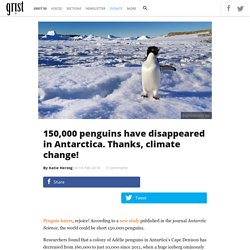
According to a new study published in the journal Antarctic Science, the world could be short 150,000 penguins. Researchers found that a colony of Adélie penguins in Antartica’s Cape Denison has decreased from 160,000 to just 10,000 since 2011, when a huge iceberg ominously named B09B became grounded in nearby Commonwealth Bay. How Climate Change is Bad for our Pets.
Have you noticed that the flea situation in the past few years has been out of control?

Our pets never used to get fleas, and suddenly it’s a huge problem in our house. Fleas aren’t the only pests on the rise. Tick and mosquito populations are also exploding right now. It turns out that climate change is creating an ideal habitat for pests, and that’s bad news for your pets. Is climate change giving the Great Barrier Reef herpes? Herpes: Nobody wants ’em, everyone’s got ’em — even, it turns out, the Great Barrier Reef.

Or, rather, a herpes-like virus is invading the Great Barrier Reef. And according to a new study published in the journal Frontiers in Microbiology, this and other viral infections on the reef might become more common as climate change ups the ecosystem’s stress levels. For the study, researchers collected bits of healthy-looking coral from a reef near Heron Island in Queensland, Australia, where recent bouts of warm temperatures, heavy rainfall, and high exposure to sunlight had the coral especially stressed out.
Back in the lab, the scientists found their coral samples were crawling with viruses — as much as two to three times more than what had previously been reported for that and other parts of the Great Barrier Reef. Your winters could be more rainy and less snowy thanks to climate change. For most states in the U.S., winters without snow would be like a Super Bowl performance without Beyonce, Donald Trump without a combover, or an overseas flight without a passport.
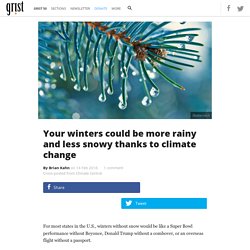
And yet that’s exactly what’s been happening. As the world warms, it’s changing the essence of winter. It’s not that less precipitation is falling (though that is happening in some areas). It’s that less winter precipitation is falling as snow, according to a new Climate Central analysis. Not all winter precipitation is created equal. To see how winter precipitation is changing, we looked at states that all see notable amounts of snow (sorry, Florida). Your kids may be getting a confusing education on climate change. This story was originally published by Mother Jones and is reproduced here as part of the Climate Desk collaboration.
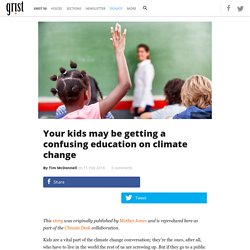
Kids are a vital part of the climate change conversation; they’re the ones, after all, who have to live in the world the rest of us are screwing up. But if they go to a public school, they could be getting a very confusing education on the subject. On Thursday, researchers published the first peer-reviewed national survey of science teachers on whether and how they teach about climate change, in the journal Science. The survey, which covered a representative sample of 1,500 middle and high school science teachers from all 50 states, found that classrooms often suffer from a problem also common in the media: the false “balance” of giving equal weight to mainstream climate science and climate change denial. But the quality of those lesson plans is inconsistent. There are a few possible reasons for this, Plutzer explained. Artist turns climate data into striking paintings.
Climate data is usually seen in pixels, spreadsheets, and maps.
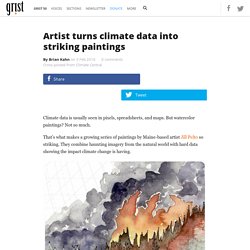
But watercolor paintings? Not so much. That’s what makes a growing series of paintings by Maine-based artist Jill Pelto so striking. They combine haunting imagery from the natural world with hard data showing the impact climate change is having. The message can be subtle, with the global average temperature graph tucked in a painting that shows wildfires raging. And by embedding that message within paintings, the works become a Trojan horse for science to reach a public that doesn’t necessarily think about data points and models. “Most of the population doesn’t pay attention to the scientific community and research,” Pelto said. Greenland is melting and dumping phosphorous into the Arctic Ocean. Here are a few things that we know about the Greenland Ice Sheet: 1) it’s big — like, almost 2.5 times the size of Texas; 2) it’s beautiful — I mean, just look at it; and 3) it’s melting.
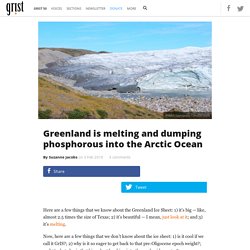
Now, here are a few things that we don’t know about the ice sheet: 1) is it cool if we call it GrIS? ; 2) why is it so eager to get back to that pre-Oligocene epoch weight? ; and 3) what else is that big galoot leaching into the sea besides water? One of these is more important than the others, so let’s start with that one. According to a new study published in the journal Global Biogeochemical Cycles, Greenland is indeed releasing more than just water into the Arctic Ocean. This is important, the researchers say, because plankton — those weird little microorganisms that serve as the base of the marine food web — feed on phosphorous.
According to Hawkings and his colleagues, not much was known about the abundance of phosphorous in ice sheet runoff before this study.